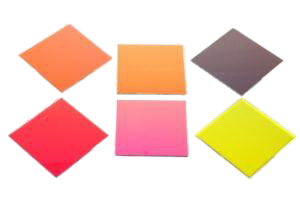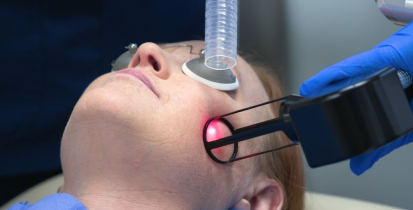

Stock Available
Bespoke Ordering Available

Knight Optical can offer a range of dichroic filters as part of our catalogue. Our filters offer superior reflection and transmission spectral properties, whilst exhibiting minimal absorption.
Dichroic filters are manufactured by applying a thin-film layer to a substrate such as soda-lime glass or borosilicate, by controlling these layers the transitions can be sharper and more precise.
Below are the different types of dichroic filters Knight Optical have available as part of our catalogue products:
- Our shortpass dichroic filters have a high transmission before the cut-off, and then a high reflection band after. Knight Optical currently offer shortpass dichroic mirrors with cut-off wavelengths ranging from 414nm to 730nm. Discover our range of shortpass filters.
- Knight Optical’s longpass dichroic filters have transmission and reflection bands divided by the cut-on wavelength, wavelengths before this cut-on point are reflected, whilst the longer wavelengths are transmitted. Knight Optical offer longpass dichroic filters with cut-on wavelengths from 420nm up to 740nm. View our range of longpass filters here.
- The bandpass dichroic filters will only transmit a certain waveband whilst blocking (in this case through reflection) the wavelengths either side. Knight Optical stock bandpass dichroic mirrors with passbands centred from 350nm to 850nm. See our selection of bandpass filters.
- Colour correction filters offer pure, true to life colour temperature adjustment for entertainment and photography. Knight Optical has daylight and tungsten conversions available.

Speak to our experts about your Custom Dichroic Filters needs today
Call +44 (0)1622 859444Make a quick enquiry about Custom Dichroic Filters Now
Dive into the forefront of optical solutions. Got questions about an optical product? Reach out now and let our expertise guide you.
Frequently Asked Questions
-
What are dichroic filters, and how do they differ from other optical filters?
-
Dichroic filters are specialised optical filters designed to selectively pass light of a small range of colours while reflecting other colours. Unlike standard colour filters, which absorb unwanted wavelengths, dichroic filters use a thin film to reflect unwanted light, making them more efficient and less prone to heating. This property is crucial for applications requiring precise colour separation or light management, such as photography, lighting, and scientific instruments.
-
What is the function of a dichroic mirror in optical systems?
-
A dichroic mirror is a type of dichroic filter that reflects certain wavelengths of light while allowing others to pass through. It is often used in applications requiring precise directional control of light, such as in projectors, lighting systems, and optical instruments. By reflecting specific wavelengths, dichroic mirrors can direct different colours of light in distinct paths, enhancing the performance of optical systems.
-
How do dichroic colour filters enhance lighting and imaging applications?
-
Dichroic colour filters are designed to transmit light of specific colours while reflecting others, making them ideal for creating effects, enhancing contrast, or correcting colour in lighting and imaging systems. These filters are widely used in theatrical lighting, photography, and microscopy to achieve vivid, saturated colours without the heat buildup associated with traditional filters, resulting in clearer and more vibrant images.
-
Can you explain the difference between shortpass, longpass, and bandpass dichroic filters?
-
Shortpass Dichroic Filters allow wavelengths shorter than a specific cutoff point to pass through while reflecting longer wavelengths. They are used in applications needing to block infrared light or pass visible light.
Longpass Dichroic Filters transmit wavelengths longer than the cutoff point and reflect shorter wavelengths, useful for infrared applications or blocking UV light.
Bandpass Dichroic Filters are designed to pass a specific range of wavelengths while blocking both shorter and longer wavelengths. This specificity makes them ideal for fluorescence microscopy, spectroscopy, and laser applications, where precise wavelength selection is critical.
-
How does the angle of incidence affect dichroic filter performance?
-
The angle of incidence refers to the angle at which light strikes the surface of a dichroic filter. This angle can significantly affect the filter’s performance, altering the wavelengths that are transmitted or reflected. Most dichroic filters are designed to operate at a specific angle, typically 45 degrees, to optimise their spectral properties. Adjusting the angle can shift the filter’s passband, allowing for fine-tuning in precision applications.
-
What are the advantages of using dichroic filters in UV applications?
-
Dichroic filters designed for UV applications, such as UV dichroic mirrors, offer high transmission of UV light while efficiently reflecting visible and infrared light. This selective transmission makes them ideal for applications requiring intense UV light without the heat or light pollution from other wavelengths, such as UV curing, photolithography, and forensic analysis. Their ability to direct UV light precisely while minimising heat buildup enhances both the efficiency and safety of these applications.
Is your question not here?
We are ready and waiting to answer any queries you may have about dichroic filters.
Quality Assurance
Essential Testing
All dichroic filters are tested in our metrology laboratory to ensure they pass their specifications. The transmission and reflection requirements are critical and these are checked with our Cary 7000 Spectrophotometer which can test these at differing angles of incidence.
Capabilities

Get in touch with us:
With our in-house state-of-the-art metrology laboratory you can be confident that your optical components will meet your requirements. You can find out more about our testing facilities here.

Operating for over 30 years
Knight Optical has been operating for over 30 years, with our managing director Colin Overton at the helm. Over this time, we have become a global leader in the production and distribution of scientific optical components and bringing quality into focus for all of our products and services that we provide.
Our Catalogue
Inside Knight Optical’s catalogue you’ll find details of the industries we serve as well as the many other services we can offer. It also showcases hundreds of our most popular products, supported by useful technical information, to help you choose the right part for your application.
Click below to view our digital catalogue now.


